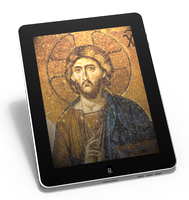

In particular, we considered whether or not an application for smart devices dedicated to downloading a new icon every day would serve the purpose of parishes that were on a budget but had access to a tablet. Such application exist for downloading new wallpapers on a daily basis – why not icons?
There were three basic areas of contention – each of which would need to be examined and evaluated before we could proceed:
1) Was there any theological or dogmatic reason to be concerned about presenting icons in this way for veneration?
2) Was the nature of the technology itself detrimental to the process of prayer?
3) Would the experience and associations people made with the tablet device – an iPad, for example – be too distracting? Would it break up the integrity of the liturgical space?
Revisiting the Controversy
From a theological point of view, there was no real legitimate bar against using technology to present icons for veneration. The resolution of the iconoclastic controversies and the resulting theology of the nature of icon veneration draws focus aways from the materials used to present the icon and toward the new creation it depicts. The material reality of Christ - the nature of transmission of the will of the unseen, uncontainable and ineffable Father through the gracious, complete and accessible image of His Son - coherently sets the stage for allowing the presence and activity of God to be respected, venerated and commemorated through physical media.
While iconophile theology allows the use of material technology to present holy icons, it is also important to examine the claims the iconoclasts were making – what did they fear about icons? How could they become impractical from a liturgical point of view?
If we are willing to accept that there were some altruistic motivations for mitigating the potential risks associated with icons, the only legitimate concern becomes the potential for idolatrous behavior. While there is no solid surviving text that presents the case of iconoclasm from their point of view, I believe it is fair to take what was understood about the nature of Hebraic idolatry and apply it to what was a very common problem that St. Paul often had to speak to in his epistles: the allure of the material world that threatens to distract and draw us out of the very moment where life with Christ is waiting. There are several ways in which electronic screens could provide material distractions that prevent a person from being able to fully utilize the icons presented through them in a liturgical setting. I’d like to look at those now.
Warm Glowing Warming Glow
Back-lit screens with induce the brain to enter a persistent relaxed alpha-wave state of activity – much like the state people intentionally experience when they are in prayer or meditation. While the brain is in this state, the person opens up, is receptive and highly suggestible. There is also an addictive component to this state of mind as endorphins are also released in the brain, giving us warm comfortable feelings.
Among propaganda and public relations strategists, the simple trigger mechanism of television opened up the capabilities of pervasive presence. When the same image appears in multiple locations and appears to see, talk and interact with you, your mind qualifies that image as omnipresent, and potentially omniscient and omnipotent. The more saturated a region is with an image, the higher the level of celebrity (or notoriety) people are willing to ascribe to it. An image that is adopted in this way is sometimes referred to in social science as a devotional anchor that will always be there - a reliable point of origin, a baseline to refer to, return to, judge from and live on.
As television peaked in popularity and the 'idol' or celebrity phenomenon was proven and established, futurists saw television and mass media of all kinds being used to provide alternative anchor points to the masses - either positive, in the case of establishing inspirational heroic archetypes, or negative in the sense of establishing fear and control - big brother is watching you because his presence is everywhere - he sees all and knows all.
Screens are unique in that the relaxation they provide has the potential to suffocate the natural desires for liturgical experience because they provide a similar mental state to prayer and require no work. The combination of screens and images can potentially replace the desire to attend services and worship with intent, because both the mental state and objects of worship are met by the technology – a person enters a relaxed and open brain state and the public relations pipeline provides personalities to serve in our mental pantheon.
That being said, I don’t want to suggest that the nature of visual screens is contradictory to their use in this setting. It takes 30 seconds of intentional exposure to a screen for your brain to enter this state. People are generally more negatively impacted by flourescent lighting fixtures. Despite the historical use and slight risks involved with the technology itself, it doesn’t seem like something that would necessarily alter or detract from their liturgical experience if it was in front them for only a few seconds.
Technological Distractions
Probably the biggest issue is the third issue – our attitudes and assumptions about technology and where it belongs. When I first started thinking about the most cost effective replacement, the obvious choice from an IT perspective would be the development of an iconography app that would run on smart mobile devices that people already owned. What about the practical considerations? How would a parish implement this solution? Would there need to be an iPad purchased solely for the sake of running this application? Would it go through a mandatory blessing period at the altar? Would it be used for other applications that were non-church related? What about non-liturgical apps?
The primary question - the simplest practical question: Would people kiss iPads? Would they place their lips on a device that was otherwise viewed as a private personal extension of who they are or is representative of what that they do? Would the distractions posed by the technology be too difficult to surpass in order to venerate the icon freely and with a whole heart?
Man's New Best Friend
Smart devices compress space and time into a small screen the size of your hand - an act which borders on the miraculous. As this miracle becomes more custom-fit and adaptable, people begin to mirror their devices. Personal devices today are not just a part of our lives - they are a part of us. And this directly impacts our response to the kind of familiarity that an icon on a iPad would demand. Putting a sacred presence on a device that may represent our work, our hobbies, our loves and vices - whatever part of us that we share with it could be a bit shocking at first.
On the positive side, having an iconography app provides individuals with the ability to allow their faith to become a facet of this alternative identity. This is also, for example, one of the great benefits of the Online Chapel application presented by the Department of Internet Ministries. Even outside of Orthodoxy, many Muslims looking for a smart phone require apps that provide prayers, prayer alarms and a compass. Technology can work this way for Orthodox also - as a call to pray, a reminder of prayer, an aid to prayer. In this sense, an icon application may be beneficial.
Cold Dead Pixels
The black and white world of ones and zeroes diametrically opposes the vast palette that represents the complexity of our lives, moods and motivations. So another distraction we encounter is simple – the screen is a ‘cold digital’ medium. A modern example of cinema playing around with the fusion of icons and screens was the role of the confession booths that were located throughout the city complexes in George Lucas’ movie THX 1138. Within the context of this film, religious iconography was presented via video screen that amplified and sterilized the religious process, orienting it towards being happy and productive in the social machine. Obviously this does not have to necessarily be the outcome of marrying iconography with backlit screens, but one cannot ignore that screens are perceived as cold and sterile devices. Especially computer screens.
A Potential Compromise
In looking at this situation, I hoped we could find a healthy technological compromise that would allow parishes to take advantage of the cost savings and convenience of having electronic forms of iconography available for rotation throughout the year, while also being able to avoid some of the technological and psychological distractions that were being unnecessarily introduced through the use of “smart devices.” The compromise that I am testing involves the use of technology in a simpler and more predictable space - the digital photo frame.
Digital picture frames are available that can present images saved to internet accessible accounts through RSS feeds. These feeds act like rolling content lists, providing timely updates in a very simple format that can be changed once and sent out to all services that subscribe to it. A digital photo frame targetting a feed of icons that is served up by a website dedicated to archiving these images could be used without distracting the congregation. The format is familiar - many digital frames look just like regular photo frames that are used with conventional icons. There would be no concern of improper use, and if the frame was being used at a camp or remote area without wireless internet connectivity images could be cached on the frame's internal memory. While the present limitation appears to be size, my personal hope is that a product can be brought to market that would provide access to this type of interaction at a scale that is more familiar.
Future Options
An up and coming alternative technology that has been touted as a drafting and drawing alternative is an electronic slate format that uses full color e-ink technology. While still in the prototype phase as of this year, it promises large scale presentation sizes, low energy consumption and high visibility in various light conditions. This may prove to be the best solution in the long term, but for parishes or camps on a budget, students at school, servicemen away, etc. a feed of festal icons displayed through a digital photo frame may provide a comfortable and accessible experience for the faithful in a variety of circumstances.
In many ways, we have a bright future to look forward to in terms of devices, because manufacturers are becoming painfully aware of the danger of distraction when it comes to getting things done. Not surprisingly, the same aspects of the technology that threaten the integrity of our liturgical participation also threaten our productivity in the workplace. While content providers are trying to find new ways to draw attention to themselves, hardware and operating system designers are working hard to allow users to reclaim their autonomy and be able to be productive on their own terms. By trying to remove themselves from the equation, technology designers view the ideal user experience as one that maximizes the benefits of the technology while minimizing the distracting elements required to do what needs to be done.
Have you tried utilizing this kind of technology in your parish? Would you be interested in participating in our development process? Please drop me a line. I'd love to hear any of your comments, critiques and suggestions.
Jacob Gorny current works as eBusiness Manager for the Orthodox Marketplace of the Greek Orthodox Archdiocese of America. He received his M.Div degree from Holy Cross Greek Orthodox School of Theology and has continued doing independent study in scripture, exilic and post-exilic theology and the confluence of Judaism and Hellenism during the intertestamental period. He can be reached at [email protected].
